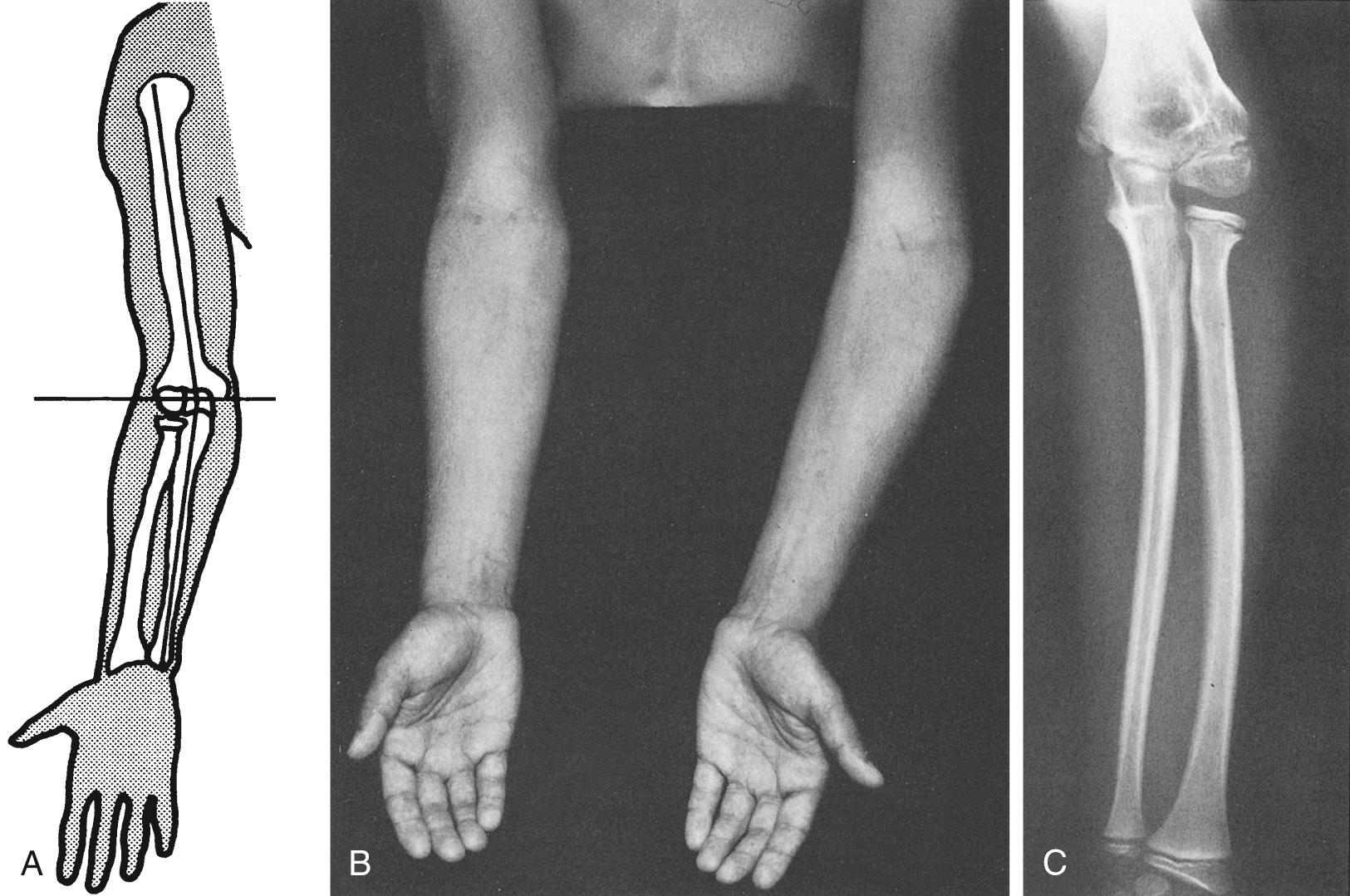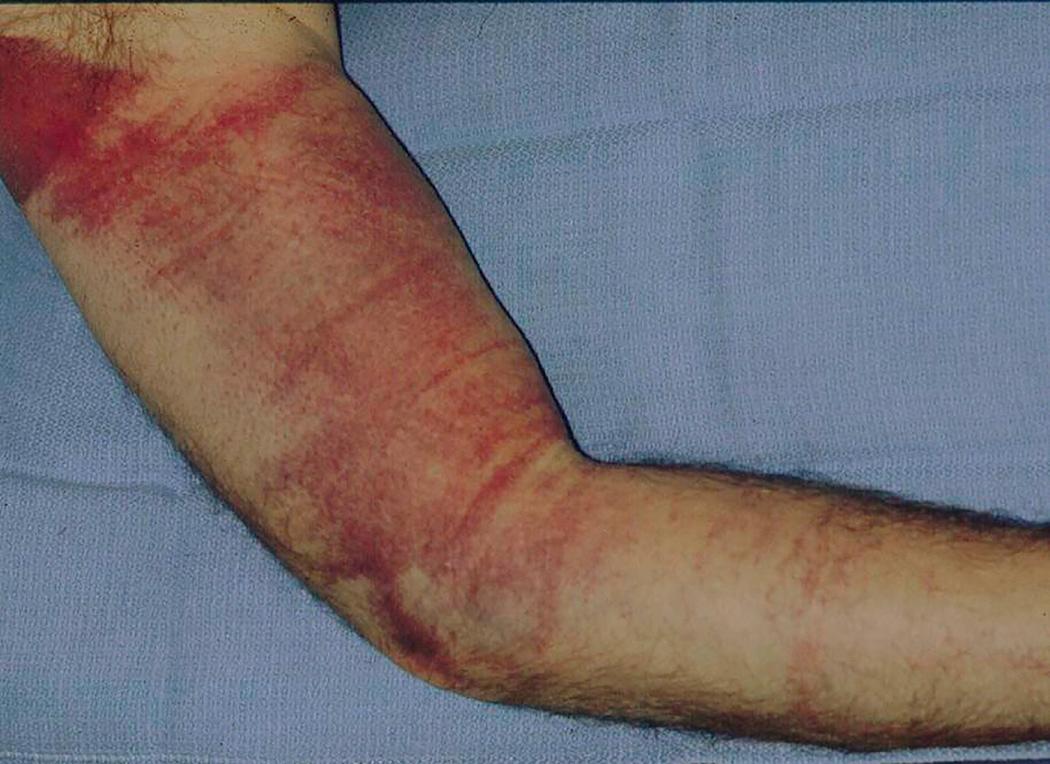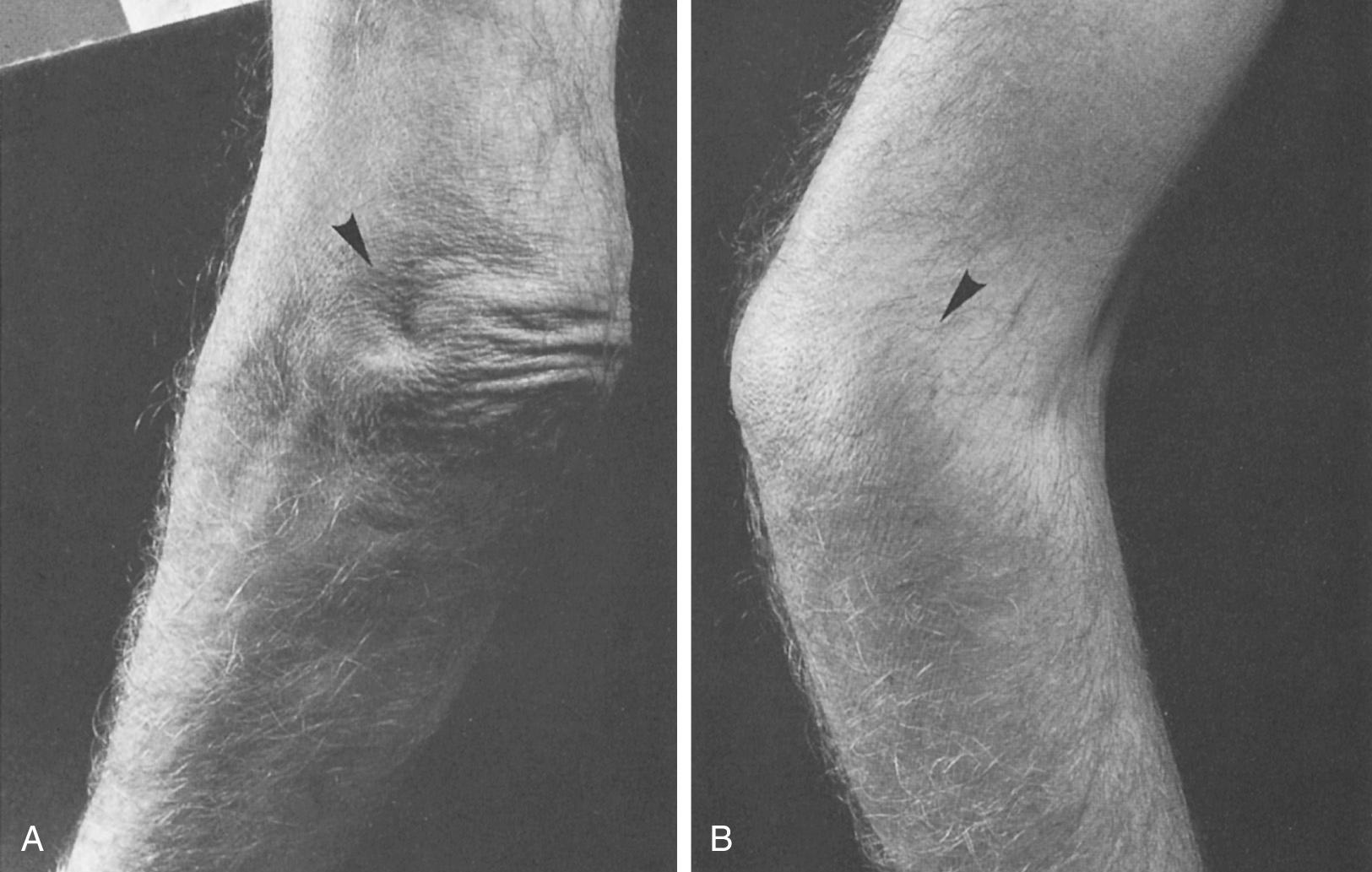Physical Address
304 North Cardinal St.
Dorchester Center, MA 02124
This chapter deals with the basics of a general comprehensive history and physical examination of the elbow. Specific and focused features of the history and examination are pictured with the various conditions described in the following sections.
Without question, the value of a precise history cannot be overstated. Pain is the most common complaint. The location, quality or type, context in which the pain occurs, duration, and severity of the pain are all important to understanding patients' pathology. Modifying factors such as whether it is radiating, intermittent, or constant, the quantity and type of analgesia used, and the association of night pain are also important characteristics.
The location of the pain clearly helps to hone in on underlying pathology. Conditions involving the radiocapitellar articulation, for example, generally evoke pain that extends over the lateral aspect of the elbow with radiation proximally to the mid humerus or distally over the forearm. The pain may be superficial, directly over the lateral epicondyle or radial head, or it may be deep and localized poorly in the area of the proximal common extensor muscle mass supplied by the posterior interosseous nerve. For reasons that remain unclear, the posterior lateral ulnohumeral joint appears to be a “watershed” referral point for a spectrum of remote conditions. Less commonly, nonspecific symptoms poorly localized to the medial aspect of the elbow can represent ulnar nerve pathology, medial epicondyle tendinopathy, or arthrosis.
The quality of the pain can also aid in directing the subsequent exam and making the correct diagnosis. Radiating, burning pain, for example, has a high association with nerve pathology, and a cervical spine examination in addition to peripheral nerve exam should also be undertaken. As is well known, pain and associated neurologic abnormality of the upper extremity are common. Today, a suspicion of cervical etiology is readily resolved with the magnetic resonance imaging (MRI) scan. Alternatively, achy pain with loading and range of motion (ROM) can guide focused physical exam maneuvers toward the articular elements.
Functionally, the elbow is the most important joint of the upper extremity, because it places the hand in a space away from or toward the body. It provides the linkage, allowing the hand to be brought to the torso, head, or mouth. Because of this, the examiner must be aware of the interplay of shoulder and wrist function as they complement the usefulness of the elbow. However, a considerable limitation of elevation and abduction function can exist at the shoulder without producing an appreciable compromise in most activities of daily living. This is true because only a relatively small amount of shoulder flexion and rotation is necessary to place the hand about the head or posteriorly about the waist or hip, and scapulothoracic motion may compensate for glenohumeral motion loss. Full pronation and supination can be achieved only when both the proximal and distal radioulnar joints are normal. The functional compromise experienced, whether it be for recreational activity or activities of daily living, therefore should be discussed in detail.
Prior treatments including surgical interventions and injections can also help in making the correct diagnosis. Finally, when considering intervention, it is extremely helpful to determine the symptom trajectory—that is, if the pain is getting better, worse, or remaining constant over a period of time.
Physical examination of the elbow is essential to the orthopedist and should focus on functional anatomy. The fundamental elements of the elbow examination are characteristic of other musculoskeletal examinations and include inspection, palpation, ROM, strength, stability, and special tests. It is important to recognize that these examination elements are dynamic and adequate assessment often combines inspection with palpation, or ROM with stability testing in “special tests” to fully elucidate the elbow pathology. For example, the radial head is most readily and easily palpated pronating and supinating the forearm to feel the radial head rotating beneath the fingers of the examining hand. Therefore, in some sense the components of the standard examination are arbitrary, and the examiner should be aware of the dynamic nature of this joint and its method of assessment. Nevertheless, a useful physical examination aids in the diagnosis of specific pathologies related to the functional anatomic elements, which include nerves, muscles and tendons, ligaments, articular elements, and bone. As discussed, on a day-to-day basis, the examination is focused on the basis of the history. Specific pathologic conditions as they relate to elements of the history and the physical exam maneuvers that aid in identifying the pathology are listed in Table 4.1 .
| Characteristic Elements of the History | Physical Exam Maneuvers to Elicit | |
|---|---|---|
| Lateral | ||
| Cutaneous neuritis (PACN, LABCN) | Burning or radiating pain; “I want to cut my arm off” | Direct palpation or percussion (i.e., Tinel) |
| Radial tunnel syndrome (PIN entrapment) | Extensor musculature “aching” (PIN) | Wrist flexion and forearm pronation |
| Rule-of-nine test | ||
| Weakness and pain with resisted long-finger extension | ||
| Lateral elbow tendinopathy (i.e., “tennis elbow”) | Pain lifting things from a bag with a pronated hand, turning doorknobs, taking milk from the fridge, shaking hands, bumping lateral elbow | Direct palpation of ECRB origin |
| TEST | ||
| Pain alone with resisted wrist extension | ||
| Laptop test | ||
| Posterolateral rotatory instability | Don't trust the elbow | PLR drawer |
| Feeling of giving way or instability when pushing out of a chair with arms | PLR pivot shift | |
| Supinated push-up test | ||
| Plica | Pop with immediate pain and then feels better | Direct palpation with flexion and pronation (anterior) |
| Direct palpation with extension and supination (posterior) | ||
| Trauma (RH, LE, Cap) | History of acute event and then pain | Direct palpation |
| Pain with pronosupination or flexion and extension | ||
| Radiocapitellar arthrosis (post trauma) | Distant trauma or surgery | Radiocapitellar load test (pain with pronation and resisted extension) |
| OCD or AVN | Gradual loss of motion +/− pain | Radiocapitellar load test (pain with pronation and resisted extension) |
| Catching and locking if loose bodies present | ||
| Medial | ||
| Medial elbow tendinopathy or tendon tear | Pain washing the face or carrying objects with arm in a supinated position | Direct palpation Flexor > pronator tendon origin |
| Face press exam | ||
| Server tray exam | ||
| Resisted flexion TEST | ||
| Moving valgus TEST (pain between 30° and 60° flexion) | ||
| Snapping triceps | Pain with flexion with a pop or snap and often tingling into the fingers (if ulnar nerve involved) | Palpation with flexion |
| Ulnar neuritis or neuropathy | Ring and little finger go to sleep when elbow is flexed (i.e., while reading in bed or wakes them up at night) | Direct palpation/Tinel |
| MUCL strain tear or instability | Decreased control and velocity while pitching (athlete) | Milking maneuver |
| History of trauma and dislocation | Moving valgus stress test | |
| Valgus extension overload | Decreased ROM and pain with deceleration and follow through | Valgus extension overload exam |
| Arm bar exam | ||
| Varus posteromedial rotatory instability | Decreased ROM after traumatic dislocation with continued varus deformity and pain with activities with the arm away from the body | Gravity-assisted varus grind test |
| Ulnohumeral arthritis | History of inflammatory conditions or trauma | Painful ROM through the mid arc with or without a load |
| Trauma (medial epicondyle or condyle fracture) | History of trauma | Direct palpation valgus stress, moving valgus stress test |
| MABCN neuroma or neuritis | Localized pain or burning with an area of hypersensitivity over an area of injury or prior surgery | Palpation or Tinel |
| Median nerve compression | Vague forearm pain that may radiate from hand to forearm | Palpation or Tinel |
| Posterior | ||
| Posterior impingement Primary osteoarthritis with osteophyte formation |
Pain when extending the arm and at the end of the day | Posterior arm bar or extension test |
| Triceps tendinopathy, avulsion, strain | Pain when pushing things away, such as opening doors or doing a bench press | Palpation |
| Weakness with resisted terminal extension | ||
| Fractured enthesophyte | Pain when pushing things away such as opening doors or doing a bench press | Direct palpation, resisted extension |
| Olecranon fracture | History of trauma | Direct palpation, resisted extension |
| Olecranon bursitis | Swelling and pain that comes and goes may be accompanied by redness and history of bumping elbow or repeated direct trauma to posterior aspect of the olecranon | Direct palpation, increased pain with extreme flexion |
| Anterior | ||
| LABCN | Localized pain or burning with an area of hypersensitivity over an area of injury or prior surgery | Tinel or percussion at anatomic location |
| Biceps tendon bursopathy, partial or complete rupture | Pain in the antecubital fossa | Direct palpation |
| Hook test | ||
| Anterior impingement | Anterior arm bar test | |
The first element in any good examination is observation, and much can be gleaned from careful inspection of the elbow joint and involved extremity. Any alteration in the skeletal anatomy is often detectable because much of the elbow joint is subcutaneous. When inspecting for pathology it is helpful to compare the elbow of interest to the contralateral side. For example, soft tissue swelling and muscle atrophy or derangement are easily observed with comparison to the contralateral side. Additionally, pathology often attributable to the elbow may lead to another diagnosis with careful observation such as swelling of the hand, skin color differences between hands, and hair changes that suggest a diagnosis of complex regional pain syndrome ( Fig. 4.1 ) rather than a specific pathology at the elbow. Scars or prior incisions should be observed and documented. Additionally, moving the elbow through a ROM during observation is a dynamic way of inspecting the joint for various types of pathology. It goes without saying that the examination should include all aspects of the elbow joint from the anterior to posterior and medial to lateral and can be performed with the patient standing or seated as appropriate.

The alignment of the elbow joint—that is, the constituent bony structure of the humerus, radius, and ulna—is examined in the anatomic position with the hands supinated and elbows extended. Axial alignment is assessed with the “carrying angle,” which is formed between the humerus and the forearm in the coronal plane ( Fig. 4.2A,B ). The average carrying angle is 10 degrees for men and 13 degrees for women although much variation exists among age, race, sex, and body weight. Angular deformities such as cubitus varus or the so-called gunstock deformity or cubitus valgus are recognized as derangements of the carrying angle (see Fig. 4.2C ).

The elbow moves from a valgus to varus alignment as ulnar–humeral flexion occurs; however, if a significant contracture is present, cubitus varus is impossible to accurately evaluate. Further, rotational deformities, particularly following supracondylar fractures, may also make the true carrying angle difficult to perceive.
A torn proximal or distal biceps tendon may be observed as a deformity or asymmetry compared with the contralateral side and, in the acute phase, may be accompanied by significant cubital and/or forearm bruising ( Fig. 4.3 ). It should be noted that the location of ecchymosis in itself does not identify the location of the pathology as the blood may pool due to dependent positioning.

Inspection from the lateral side may identify joint contracture and its severity. This must be done carefully with the elbow in the sagittal plane to accurately assess the degree of the contracture as internal rotation at the shoulder may change the apparent severity of a contracture ( Fig. 4.4A–C ). On the lateral aspect of the elbow a triangle is formed between the radial head, the tip of the olecranon, and the lateral epicondyle ( Fig. 4.5A ). Within this triangle lies the intracondylar recess, which is a natural dimple when viewed from the lateral side.


Soft tissue derangements including synovitis may also be present, and the normal dimple is obliterated with effusions (see Fig. 4.5B ). Thin, taut, adherent skin over the lateral epicondyle may be indicative of multiple cortisone injections for refractory lateral epicondyle tendinopathy.
Osseous pathology such as a posterior dislocation or fracture of the radial head may be perceived as an obvious prominence from the lateral aspect of the joint ( Fig. 4.6A,B ). This finding is often more impressive than is loss of motion.

Become a Clinical Tree membership for Full access and enjoy Unlimited articles
If you are a member. Log in here